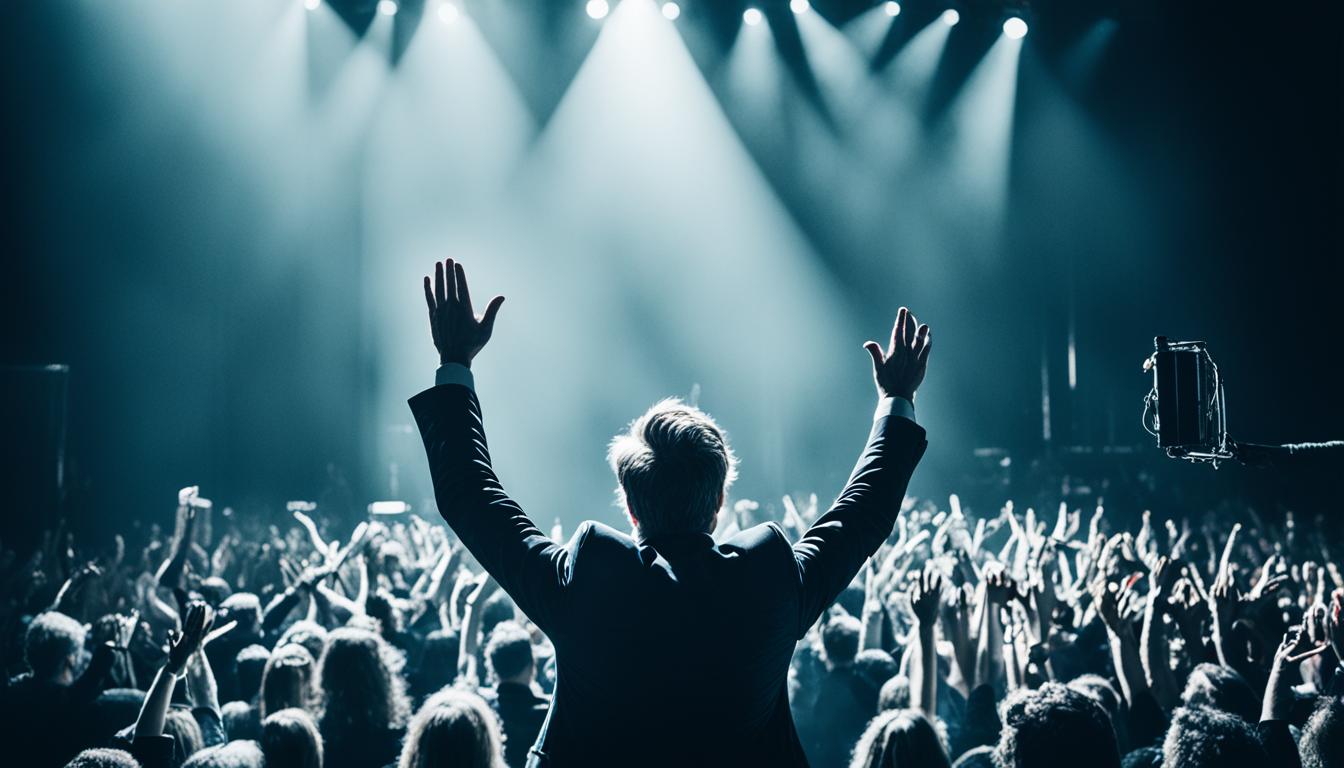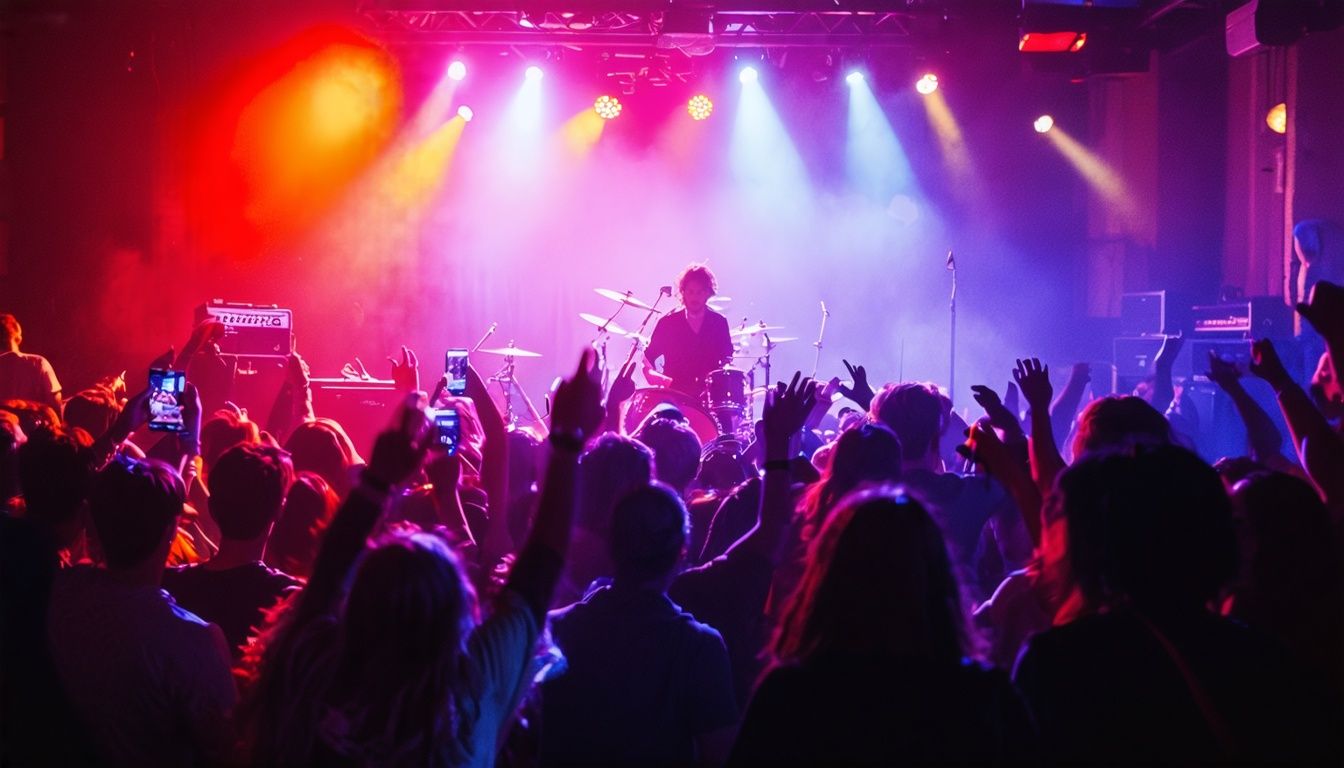We’re deep in the music scene, exploring concert photography. Our journey takes us from cozy bars to giant arenas. Capturing live performances is our mission. We seek the emotion in every note. This exploration reveals unique challenges and joys in each setting. With cameras ready, we collect concert photography tips at each show. Our goal? To turn music’s stories into visual art.
Key Takeaways
- Nurturing photography skills in both small venues and large arenas broadens our creative horizons.
- Intimate venues serve as the perfect workshop for refining the art of capturing live performances.
- Large arenas challenge us to innovate photography techniques under more complex conditions.
- Balancing the technicalities of both settings is crucial for growth in music photography.
- Building relationships within the music scene is instrumental for gaining access to high-profile events.
- Sharing tips and experiences enriches the collective knowledge of concert photographers.
The Art of Concert Photography in Small Venues
Small venues offer a special chance to capture live performances up close. They provide a unique setting for stunning music photos. As photographers, we find these places perfect for showing the energy of live music. Let’s look into how photographing intimate concerts can tell a deep story with each picture.
Advantages of Intimate Spaces
In small venues, the magic of music feels real, close to the camera. We get to see the artist’s passion and their bond with fans. These moments let us catch raw, powerful shots that big places can’t match. It’s where the true spirit of music photography shines.
Tips for Capturing the Up-Close Experience
Getting good at handling concert lights is key in dark, small venues. You need patience and quick reflexes. This lets us catch the perfect moment, even in fast action and low light. Using a high ISO and fast lens helps grab those energetic moments, turning low light into a plus for our photos. We use shadow and color to show the real feel of the concert.
Challenges in Smaller Venues and Overcoming Them
Shooting in small venues means dealing with tight spots and little space to move. But, we see this as a way to get creative. We use the closeness to the performers and the crowd’s energy. This makes us think of new ways to take lively, interesting shots.
We get better with each challenge in these cozy spaces. It boosts our skills in capturing live performances everywhere. This hard work shapes our unique style. It shows our subjects and our own creative eye.
Shooting Concerts in the Grandeur of Large Arenas
Entering the world of arena concert photography is thrilling. These massive venues host epic shows. The energy from the crowd fills the air, making every moment exciting. Our challenge is to capture the essence of these concerts in photos that bring the show to life.
Preparing to shoot concerts in big arenas starts early. Finding the right spot to shoot from takes planning and quick moves. Getting photo passes is crucial. They let us get close to capture amazing moments.
With the roar of the audience in the background, and the vibrant lights illuminating the stage, there is a pulse-pounding excitement to capturing live performances. It’s a dance between photographer, artist, and audience, choreographed by spontaneity and precision. – Anon
Big concerts have strict rules, like the ‘first three, no flash’ policy. This makes us try to make every shot perfect. Often, we shoot from far away at the soundboard. But, our lenses help us capture up-close emotions and energy on stage.
- Adapting to venue size dynamics
- Maximizing the first three songs
- Optimizing equipment for long-distance shots
At these shows, every second counts. Becoming skilled at shooting concerts in large venues shows our ability to anticipate and react quickly. It’s exciting to tell the story of a night filled with music and memories through our photos.
Concert Photography in Small Venues vs. Large Arenas: The Technical Divide
When we talk about concert photography tips, there’s a clear split. Small venues offer a cozy feel, while large arenas dazzle with their size. As music photography experts, we need to adjust to either setting. This includes understanding the technical needs of shooting concerts in these places.
Camera Equipment Considerations
Choosing the right equipment is crucial for capturing the essence of live shows. In small venues, being close to the action lets you use prime lenses for clear, detailed photos. But in big arenas, you’ll need a zoom lens. It should cover wide shots and zoom in on performers from a distance.
Navigating Lighting and Acoustics
Small bars and big arenas differ a lot in lighting and sound. In small places, you deal with low light and sound bouncing around. You’ll need lenses that let in more light and cameras good at high ISOs. Big venues have better lights, but keeping your exposure right can be tough with changing stage lights.
Adapting Your Style to the Venue Size
The size of the venue affects your creative style. In small venues, you can take shots that feel personal and tell a story. In large arenas, your photos should show the event’s scale. They should capture the crowd’s energy and the performers’ spirit.
| Consideration | Small Venue | Large Arena |
|---|---|---|
| Lens Type | Prime (35mm, 85mm) | Zoom (70-200mm) |
| Lighting Conditions | Dim, Requires Fast Lens | Dynamic, Requires Flexible Exposure |
| Preferred ISO Range | Higher ISO for Quality | Varied ISO Depending on Light Show |
| Style Focus | Intimacy & Raw Emotion | Scale & Spectacle |
| Acoustic Challenges | Unpredictable Reflections | Managed Acoustics |
To become great at concert photography, you need skill and knowledge. This includes knowing how different venues affect your work. Our tips are designed to help you excel, whether in small spaces or big ones. With them, your music photography will always capture the moment perfectly.
The Evolution of a Music Photographer: Transitioning From Bars to Stadiums
We start our music photography journey in the small bars. Then we move up to the big stadiums. We learn and grow with every photo we take. Our skills in music photography improve as we capture the spirit of live shows. With every shot, we turn passion into memorable images.
Building Your Portfolio in Local Scenes
We begin in smaller venues, laying our portfolio’s groundwork. By focusing on live music photography in these places, we learn to play with angles and light. Capturing the music scene’s heart through our camera is key. These early experiences teach us important concert photography tips.

Securing Photo Passes for Bigger Venues
As we get known, we aim for bigger stages. Getting a photo pass is our goal. It’s our key to the world of music photography. It shows we’re serious and match the industry’s vibe.
Developing Relationships Within The Music Industry
Networking is about making real connections. We meet artists, promoters, and venue owners. These connections help us as we grow in concert photography tips and places. They support our journey from small bars to big stadiums.
| Local Scenes | Stadiums |
|---|---|
| Up-close and personal shots | Wide-angle views capturing the grandeur of the space |
| Freestyle shooting, often without photo passes | Shooting with photo passes under strict guidelines |
| Building foundational skills in challenging lighting | Utilizing advanced settings for dynamic stage lights |
| Nurturing local music community relationships | Expanding network to include industry professionals |
Nurturing the Connection: Audience Engagement at Different Venues
When we talk about capturing live performances, there’s an element that often goes unnoticed but remains integral to the memories we craft—audience engagement. For us, shooting concerts is not only about the high-octane performance on stage but also about encapsulating the quintessential human connection that it fosters. Different venues shape this narrative distinctly, with each offering a window into the souls of those gathered for the rhythm and rhyme.
At a small venue, it’s about capturing those intrinsic nuances—a head slightly tilted in awe, hands rhythmically tapping, eyes shut in trance. The proximity and simplicity inherent in these spaces magnify the intimate ties between the artist and their admirers. We continually strive to immortalize these intimate connections through our lenses.
To glean concert photography tips unique to these settings, consider the below strategies:
- Position yourself to catch spontaneous interactions between the crowd and performers.
- Use a wide aperture to keep the focus on individual faces amid the dim lighting.
- Anticipate the peak moments of engagement like crowd sing-alongs.
On the flip side, larger venues teem with a sea of anticipation and collective spirit. Here, the challenge is to portray the vast tapestry of connectedness that spans the arena. Shooting concerts at such a scale demands an entirely different approach—one that balances detail with the grandeur of the shared experience.
- Employ a wide-angle lens to capture the expansiveness of the crowd.
- Look for patterns and symmetry in the audience arrangement to create compelling compositions.
- Time your shots for when stage lighting illuminates large swathes of spectators.
And yet, regardless of the venue size, our objective remains the same—to convey the tangible energy and emotion offstage as powerfully as we do the action onstage. Our collective endeavor in capturing live performances is complete only when both these narratives coalesce into a single, potent story of the night.
| Venue Type | Audience Interaction | Photography Approach |
|---|---|---|
| Small Venue | Close and personal | Look for intimate gestures, use selective focus |
| Large Arena | Wide and collective | Utilize wide-angle shots, emphasize crowd dynamics |
The Business of Concert Photography: Understanding the Venue Scale
Music photography is more than a creative journey. It’s a business that needs smart thinking, especially when it comes to money matters influenced by the size of the venue. The ever-changing world of live music photography brings different challenges and chances to make money, depending on where you are shooting. Here’s a look at how we change our approach for each venue size. This helps keep our passion alive and ensures our business thrives.

Monetizing Your Concert Photography
Small venues offer a chance to build our portfolio with unique, raw images. They might not get us famous, but they’re affordable and easy to get into. In these spots, capturing moments full of intimacy and character is key. This helps get consistent work that, while not always high-paying, is vital for a concert photographer’s growth.
Pitching Your Work to Publications
Moving to bigger venues, our chance to impress big magazines increases. But, it’s not just about having great concert photography tips. It’s about knowing the market and what magazine editors want. Matching our work with a publication’s style could get our photos featured in leading magazines.
Opportunities and Limitations Based on Venue Capacity
Small and large venues each have their ups and downs. In big places, we might get more fame and money but getting access is tough. It’s competitive, and rules can limit chances. On the flip side, small venues may offer less fame but give us more gigs. This consistent work helps us improve in music photography. This balancing act reminds us of our passion for capturing live music’s essence, no matter the venue size.
Behind the Lens: Stories From the Pit to the Press Box
For us, concert photography in small venues vs. large arenas is more than just pictures. Each shot tells a story, capturing a piece of time with melody and color. The size of the place changes our techniques and the stories we tell.
From dive bars to press boxes, we aim to catch the show’s energy. Capturing live performances in these places gives us unforgettable tales. Here, spontaneity and precision meet, letting creativity thrive.
Anecdotes from Seasoned Professionals
Our journey has been full of thrilling moments. We’ve got stories from working with other photographers and meeting artists. Some of our best shots were unplanned, like catching stage divers by chance.
Lessons Learned in Diverse Concert Environments
Each venue teaches us to adapt. In small pubs, we need a wide aperture and quick reflexes. Big arenas demand long lenses and a steady hand. These places make us better at our craft.
The Impact of Venue Size on the Photography Experience
Small and big venues offer different stories. From quiet acoustic sets to loud rock concerts, each has its vibe. Our goal is always the same: to capture moments that show the essence of live music.
We need to be flexible and observant to succeed. From small clubs to big stadiums, we tell stories of the concert scene’s vibrant life.
Chasing the perfect shot, we aim to catch the essence of performances. These experiences build our portfolio and remind us what concert photography is all about. The venue sets the scene, but the moments we capture touch the heart.
Conclusion
In our exciting journey through concert photography, we explore both small venues and large arenas. Each offers its own unique challenges and joys. Small venues let us connect deeply with music, allowing freedom to try new things. Here, we learn to catch the raw emotion and energy of live music.
Large arenas test our skills in new ways. They demand careful planning and creativity to capture each moment. In these big spaces, we aim to show the event’s grand scale and the audience’s shared excitement.
No matter the place, our goal stays the same. We aim to capture the music’s spirit that touches hearts. Our passion for music photography sharpens our skills, whether in a dive bar or a large stadium. Together with other photographers, we cherish each performance. It deepens our love for telling the stories behind the music.
FAQ
What are the main differences between concert photography in small venues and large arenas?
Small venue concert photography gives a closer, more personal feel. You can easily get near the stage for up-close shots. This captures the true energy and emotion of the concert.
In large arenas, it’s tougher to get close and deal with big crowds. Though challenging, it lets you capture the spectacle of big concerts.
What equipment is best suited for shooting concerts in small venues?
In small venues, photographers use fast prime lenses like 35mm or 85mm. These lenses work well in low light and help capture personal views of the performance. Having the ability to move quickly is crucial in these compact spaces.
What are some common challenges when photographing concerts and how can you overcome them?
Photographers face low light, unpredictable movements, and strict rules. Mastering manual settings, using high ISOs, and fast shutter speeds help. Knowing concert lighting helps you adapt to changes.
Building good relationships with venues and artists can also give you better access and positions for shooting.
How can a photographer transition from shooting at small venues to getting access to larger arenas?
To move to larger venues, build a strong portfolio with images from small gigs. Network with industry pros and get your work into reputable publications. This proves your skill in concert photography and helps get passes for big venues.
What is the ‘first three, no flash’ rule in concert photography, and why is it important?
The ‘first three, no flash’ rule is key in big concerts. It limits shooting to the first three songs without flash. This reduces distractions for performers and the crowd, while giving photographers a chance to capture the show.
How does audience engagement differ in photography between small venues and large arenas?
In small venues, the connection with the audience is direct and personal. Photographers can capture the crowd’s reactions up close. But large arenas show the shared excitement of the fans, with shots that show how many are enjoying the concert together.
What are some strategies for monetizing concert photography?
Photographers can sell photos or license them to fans, bands, and media. Submitting to music magazines and websites, or offering services for band promos works too. Knowing your market and building a photography brand are key to making money.
Can you share some stories or lessons from photographers who have experienced both small venue and large arena concert photography?
Photographers love the rush of shooting in small venues, where there’s always a chance for unique shots. Shooting in large arenas offers a different thrill, capturing big moments. Success there requires good timing and preparation due to strict rules.



